Wenmeng Yu
CogVLM2: Visual Language Models for Image and Video Understanding
Aug 29, 2024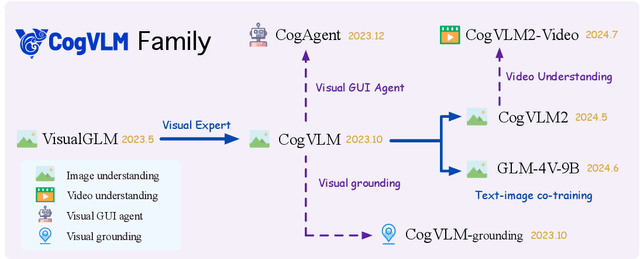

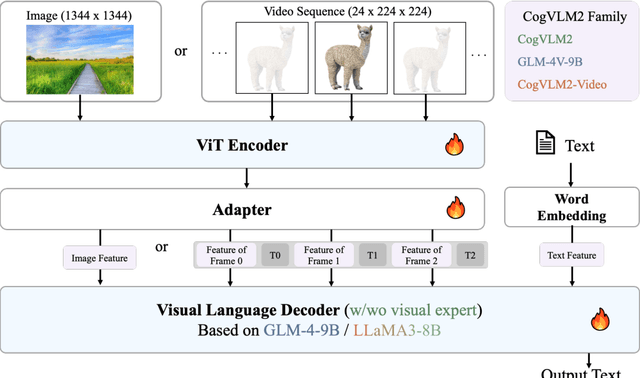
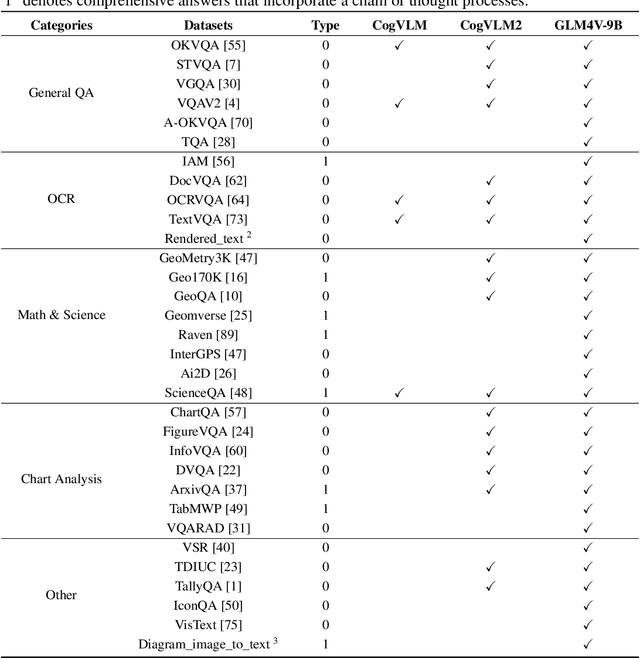
Abstract:Beginning with VisualGLM and CogVLM, we are continuously exploring VLMs in pursuit of enhanced vision-language fusion, efficient higher-resolution architecture, and broader modalities and applications. Here we propose the CogVLM2 family, a new generation of visual language models for image and video understanding including CogVLM2, CogVLM2-Video and GLM-4V. As an image understanding model, CogVLM2 inherits the visual expert architecture with improved training recipes in both pre-training and post-training stages, supporting input resolution up to $1344 \times 1344$ pixels. As a video understanding model, CogVLM2-Video integrates multi-frame input with timestamps and proposes automated temporal grounding data construction. Notably, CogVLM2 family has achieved state-of-the-art results on benchmarks like MMBench, MM-Vet, TextVQA, MVBench and VCGBench. All models are open-sourced in https://github.com/THUDM/CogVLM2 and https://github.com/THUDM/GLM-4, contributing to the advancement of the field.
AlignMMBench: Evaluating Chinese Multimodal Alignment in Large Vision-Language Models
Jun 14, 2024Abstract:Evaluating the alignment capabilities of large Vision-Language Models (VLMs) is essential for determining their effectiveness as helpful assistants. However, existing benchmarks primarily focus on basic abilities using nonverbal methods, such as yes-no and multiple-choice questions. In this paper, we address this gap by introducing AlignMMBench, a comprehensive alignment benchmark specifically designed for emerging Chinese VLMs. This benchmark is meticulously curated from real-world scenarios and Chinese Internet sources, encompassing thirteen specific tasks across three categories, and includes both single-turn and multi-turn dialogue scenarios. Incorporating a prompt rewrite strategy, AlignMMBench encompasses 1,054 images and 4,978 question-answer pairs. To facilitate the evaluation pipeline, we propose CritiqueVLM, a rule-calibrated evaluator that exceeds GPT-4's evaluation ability. Finally, we report the performance of representative VLMs on AlignMMBench, offering insights into the capabilities and limitations of different VLM architectures. All evaluation codes and data are available on https://alignmmbench.github.io.
CogAgent: A Visual Language Model for GUI Agents
Dec 21, 2023



Abstract:People are spending an enormous amount of time on digital devices through graphical user interfaces (GUIs), e.g., computer or smartphone screens. Large language models (LLMs) such as ChatGPT can assist people in tasks like writing emails, but struggle to understand and interact with GUIs, thus limiting their potential to increase automation levels. In this paper, we introduce CogAgent, an 18-billion-parameter visual language model (VLM) specializing in GUI understanding and navigation. By utilizing both low-resolution and high-resolution image encoders, CogAgent supports input at a resolution of 1120*1120, enabling it to recognize tiny page elements and text. As a generalist visual language model, CogAgent achieves the state of the art on five text-rich and four general VQA benchmarks, including VQAv2, OK-VQA, Text-VQA, ST-VQA, ChartQA, infoVQA, DocVQA, MM-Vet, and POPE. CogAgent, using only screenshots as input, outperforms LLM-based methods that consume extracted HTML text on both PC and Android GUI navigation tasks -- Mind2Web and AITW, advancing the state of the art. The model and codes are available at https://github.com/THUDM/CogVLM .
CogVLM: Visual Expert for Pretrained Language Models
Nov 06, 2023Abstract:We introduce CogVLM, a powerful open-source visual language foundation model. Different from the popular shallow alignment method which maps image features into the input space of language model, CogVLM bridges the gap between the frozen pretrained language model and image encoder by a trainable visual expert module in the attention and FFN layers. As a result, CogVLM enables deep fusion of vision language features without sacrificing any performance on NLP tasks. CogVLM-17B achieves state-of-the-art performance on 10 classic cross-modal benchmarks, including NoCaps, Flicker30k captioning, RefCOCO, RefCOCO+, RefCOCOg, Visual7W, GQA, ScienceQA, VizWiz VQA and TDIUC, and ranks the 2nd on VQAv2, OKVQA, TextVQA, COCO captioning, etc., surpassing or matching PaLI-X 55B. Codes and checkpoints are available at https://github.com/THUDM/CogVLM.
M-SENA: An Integrated Platform for Multimodal Sentiment Analysis
Mar 23, 2022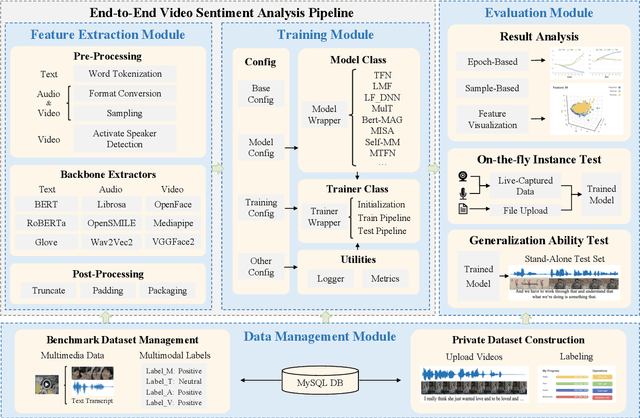
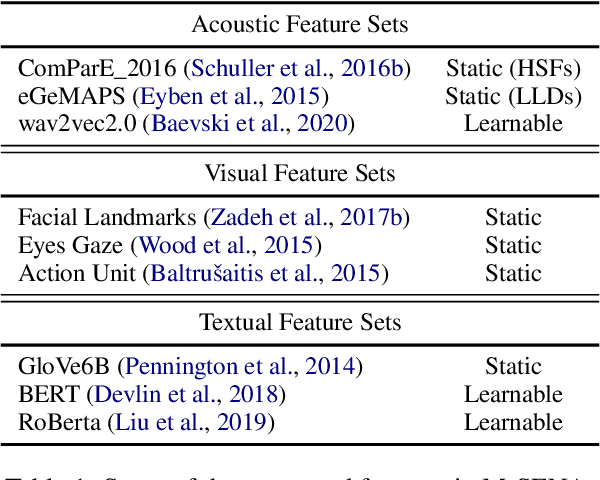
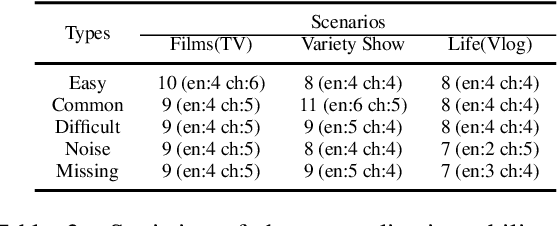
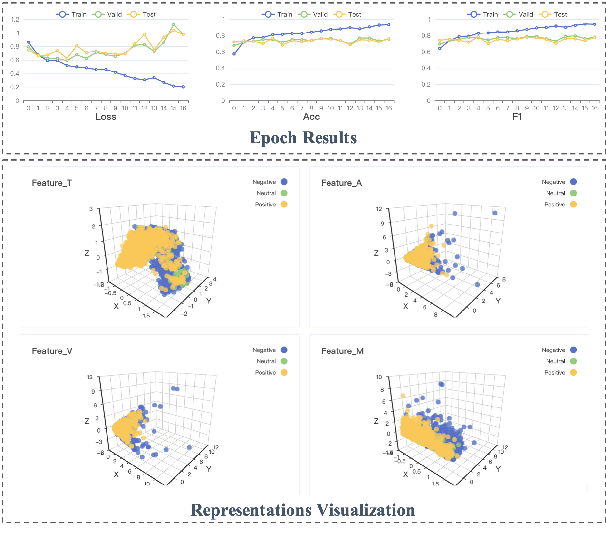
Abstract:M-SENA is an open-sourced platform for Multimodal Sentiment Analysis. It aims to facilitate advanced research by providing flexible toolkits, reliable benchmarks, and intuitive demonstrations. The platform features a fully modular video sentiment analysis framework consisting of data management, feature extraction, model training, and result analysis modules. In this paper, we first illustrate the overall architecture of the M-SENA platform and then introduce features of the core modules. Reliable baseline results of different modality features and MSA benchmarks are also reported. Moreover, we use model evaluation and analysis tools provided by M-SENA to present intermediate representation visualization, on-the-fly instance test, and generalization ability test results. The source code of the platform is publicly available at https://github.com/thuiar/M-SENA.
Learning Modality-Specific Representations with Self-Supervised Multi-Task Learning for Multimodal Sentiment Analysis
Feb 09, 2021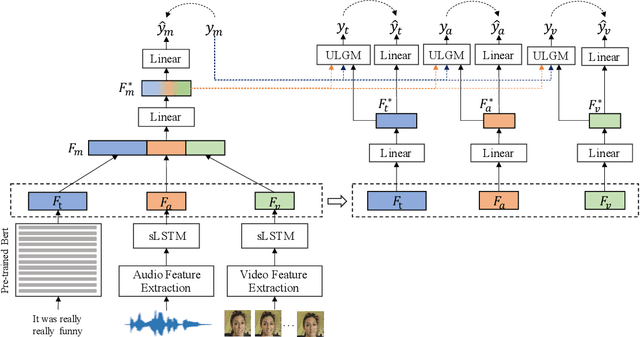
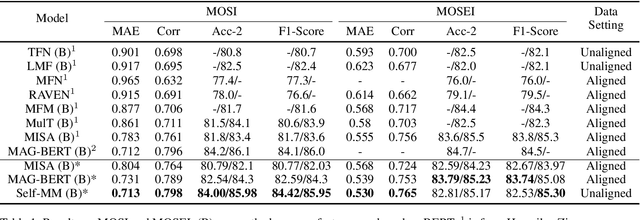
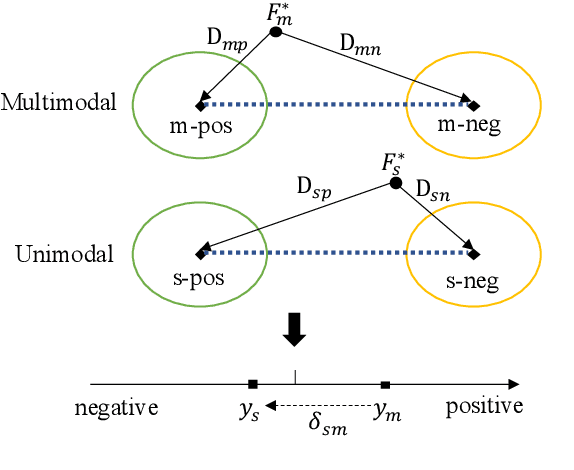

Abstract:Representation Learning is a significant and challenging task in multimodal learning. Effective modality representations should contain two parts of characteristics: the consistency and the difference. Due to the unified multimodal annotation, existing methods are restricted in capturing differentiated information. However, additional uni-modal annotations are high time- and labor-cost. In this paper, we design a label generation module based on the self-supervised learning strategy to acquire independent unimodal supervisions. Then, joint training the multi-modal and uni-modal tasks to learn the consistency and difference, respectively. Moreover, during the training stage, we design a weight-adjustment strategy to balance the learning progress among different subtasks. That is to guide the subtasks to focus on samples with a larger difference between modality supervisions. Last, we conduct extensive experiments on three public multimodal baseline datasets. The experimental results validate the reliability and stability of auto-generated unimodal supervisions. On MOSI and MOSEI datasets, our method surpasses the current state-of-the-art methods. On the SIMS dataset, our method achieves comparable performance than human-annotated unimodal labels. The full codes are available at https://github.com/thuiar/Self-MM.
 Add to Chrome
Add to Chrome Add to Firefox
Add to Firefox Add to Edge
Add to Edge